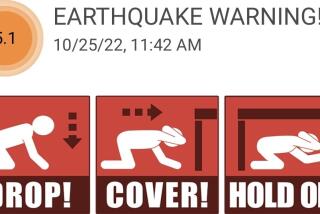Smartphone apps let neighbors report water wasters

- Share via
With Californians being urged to cut water use as the state’s historic drought drags on, a growing number of local water agencies are enlisting the public to play water cop with their smartphones.
From Long Beach to Placer County, officials are rolling out apps that allow users to snap and send photos of homes and businesses that are violating watering restrictions or operating broken and wasteful irrigation systems.
The apps put more boots on the ground to spot waste and leaks that might go unnoticed, officials say. They say the high-tech citizen reporting programs are intended to encourage water conservation, and not to be used as evidence to fine offenders.
But at least one private company is taking things a step further. Creators of Vizsafe, a neighborhood watch app, have added a feature allowing users to map photos of water wasters — a practice dubbed “drought shaming” on Twitter and Instagram.
The company’s app provides people with useful information about their communities, said Peter Mottur, chief executive of Rhode Island-based Vizsafe. “People have a right to hold others accountable and that is what I think we are doing.”
Privately reporting excessive water use or leaks that have gone unnoticed is “fantastic,” said Karen North, a professor of social media and psychology at USC’s Annenberg School for Communication and Journalism.
“But to the extent that people then publicly shame each other for that behavior,” she said, it could force “a lot of really solid compliance, but it can also lead to a lot of animosity.”
Matthew Kahn, a professor of economics at UCLA’s Institute of the Environment and Sustainability, said the mere existence of the apps could increase conservation.
“While we all fear Orwell’s Big Brother,” he said, “we all try harder when we are being watched, even if that is a little creepy. You may need these social apps to motivate these behavioral changes.”
Long Beach’s water department released its first app to report water waste in 2010, but revamped it in August so users could add photos, said Melissa Keyes, a special projects coordinator who helped design the service.
The number of app-generated complaints initially increased five-fold, to about 25 a day, but has recently returned to lower levels, she said. “We wanted people to feel they had an outlet to get their frustrations out when they were doing their part and they saw others weren’t,” she said.
The anonymous complaints typically prompt a letter from the water agency to the property owner. Most complaints involve broken sprinklers or irrigation leaks, Keyes said, and often the owners aren’t aware of the problem. So far the city hasn’t seen fence fights erupt over use of the app, she said.
The water-waste app provided downtown Long Beach resident Sherry Ray-Von a convenient way to deal with a nearby apartment building resident who she said washed his car every day for months.
She tried to discuss the matter with the man, she said, but he shrugged her off.
When the upgraded city app came, she thought: “This is great. This is my chance to get this guy.”
She said she snapped a photo of the runoff, sent it to the water department and a few days later, the car washer stopped.
In Placer County, the water agency released a multipurpose water-saving app in May. It lets users report water waste, but it also features a shower timer that estimates how many gallons a person uses. So far, the agency has received 30 complaints, mostly about water runoff, said Matt Young, the agency’s director of customer services.
The Santa Clara Valley Water District forwards app complaints, most involving over-watering or irrigating outside permitted periods, to five water inspectors in the field, who remind offenders of the water usage rules, said spokesman Marty Grimes.
In Palm Springs, 67-year-old real estate salesman Victor Yepello said he used to see broken sprinklers and excessive watering when he biked around the city. But when he got home, he’d often forget the locations or to call the local water agency to complain, he said.
Then he discovered the Desert Water Agency’s new waste-reporting app. This summer, Yepello saw a small river of runoff coursing down Mesquite Avenue from a nearby house, so he stopped, snapped a photo and sent it and the address to the water agency.
Within a few hours, he said, an email came back telling him the problem was a broken irrigation line the property owner hadn’t noticed.
“I don’t see it as a way to snitch on your neighbor,” Yepello said. “If you spot something that is a real problem, report it.”
More to Read
Sign up for Essential California
The most important California stories and recommendations in your inbox every morning.
You may occasionally receive promotional content from the Los Angeles Times.











